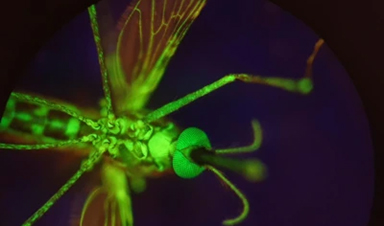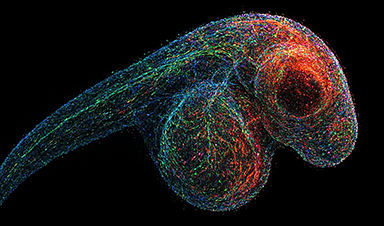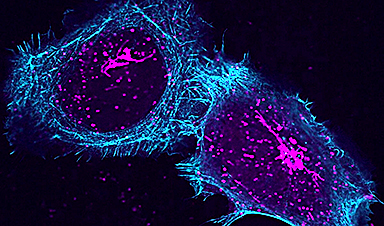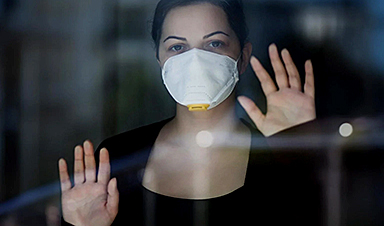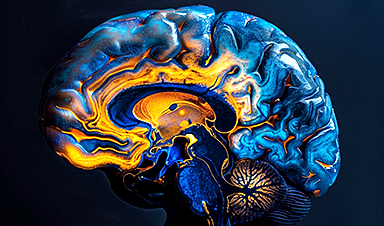Many efforts to reduce transmission of diseases like COVID-19 and the flu have focused on measures such as masking and isolation, but another useful approach is reducing the load of airborne pathogens through filtration or germicidal ultraviolet light. Conventional UV sources can be harmful to eyes and skin, but newer sources that emit at a different wavelength, 222 nanometers, are considered safe.
The findings are reported in the journal Environmental Science & Technology, in a paper by recent MIT postdoc Victoria Barber, doctoral student Matthew Goss, Professor Jesse Kroll, and six others at MIT, Aerodyne Research, and Harvard University.
While Kroll and his team usually work on issues of outdoor air pollution, during the pandemic they became increasingly interested in indoor air quality. Usually, little photochemical reactivity happens indoors, unlike outdoors, where the air is constantly exposed to sunlight. But with the use of devices to clean indoor air using chemical methods or UV light, “all of a sudden some of this oxidation is brought indoors,” triggering a potential cascade of reactions, Kroll says.
Initially, the UV light interacts with oxygen in the air to form ozone, which is itself a health risk. “But also, once you make ozone, there’s a possibility for all these other oxidation reactions,” Kroll says. For example, the UV can interact with the ozone to produce compounds called OH radicals, which are also powerful oxidizers.
Barber, who is now an assistant professor at the University of California at Los Angeles, adds, “If you have volatile organic compounds in the environment, which you do basically in all indoor environments, then these oxidants react with them and you make these oxidized volatile organic compounds, which in some cases turn out to be more harmful to human health than their unoxidized precursors.”
The process also leads to the formation of secondary organic aerosols, she says. “Again, this stuff is harmful to breathe, so having it in your indoor environment is not ideal.”
The formation of such compounds is particularly problematic in the indoors, Kroll says, because people spend so much of their time there, and low ventilation rates can mean these compounds could accumulate to relatively high levels.
Having studied such processes in outdoor air for years, the team had the right equipment in hand to observe these pollution-forming processes indoors directly. They carried out a series of experiments, first exposing clean air to the UV lights inside a controlled container, then adding one organic compound at a time to see how they each affected the compounds that were produced. Although further research is needed to see how these findings apply to real indoor environments, the formation of secondary products was clear.
The devices that make use of the new UV wavelengths, called KrCl excimer lamps, are still relatively rare and expensive. They’re used in some hospital, restaurant, or commercial settings rather than in homes. But while they have sometimes been touted as a substitute for ventilation, especially in hard-to-ventilate older buildings, the new study suggests that’s not appropriate.
“Our big finding was that these lights are not a replacement for ventilation, but rather a complement to it,” says Kroll, who is a professor of civil and environmental engineering, and of chemical engineering.
Some have proposed that with these devices, “maybe if you could just deactivate the viruses and bacteria indoors, you wouldn’t need to worry about ventilation as much. What we showed is that, unfortunately, that’s not necessarily the case, because when you have less ventilation, you get a buildup of these secondary products,” Kroll says.
He suggests a different approach: “There may be a sweet spot in which you’re getting the health benefits of the light, the deactivation of pathogens, but not too many of the disbenefits of the pollutant formation because you’re ventilating that out.”
The results so far are from precisely controlled lab experiments, with air contained in a Teflon bag for testing, Barber points out. “What we’re seeing in our bag is not necessarily directly comparable to what you would see in a real indoor environment,” she says, “but it does give a pretty good picture of what the chemistry is that can happen under radiation from these devices.”
Goss adds that “this work allowed us to validate a simple model that we could plug in parameters to that are more relevant to actual indoor spaces.” In the paper, they use this information “to try to apply the measurements we’ve taken to estimate what would happen in an actual indoor space.” The next step in the research will be to attempt follow-up studies taking measurements in real-world indoor spaces, he says.
“We’ve shown that these are a potential concern,” Kroll says. “But in order to understand what the full real-world implications are, we need to take measurements in real indoor environments.”
“These 222-nanometer radiation devices are being deployed in bathrooms, classrooms, and conference rooms without a full accounting of the potential benefits and/or harm associate with their operation,” says Dustin Poppendieck, a research scientist at the National Institute for Standards and Technology, who was not associated with this study.
“This work lays the foundation for a proper quantification of potential negative health impacts of these devices. It is important this process is completed prior to relying on the technology to help prevent the next pandemic.”
More information: Victoria P. Barber et al, Indoor Air Quality Implications of Germicidal 222 nm Light, Environmental Science & Technology (2023). DOI: 10.1021/acs.est.3c05680
Journal information: Environmental Science & Technology

News
New Blood Test Detects Alzheimer’s and Tracks Its Progression With 92% Accuracy
The new test could help identify which patients are most likely to benefit from new Alzheimer’s drugs. A newly developed blood test for Alzheimer’s disease not only helps confirm the presence of the condition but also [...]
The CDC buried a measles forecast that stressed the need for vaccinations
This story was originally published on ProPublica, a nonprofit newsroom that investigates abuses of power. Sign up to receive our biggest stories as soon as they’re published. ProPublica — Leaders at the Centers for Disease Control and Prevention [...]
Light-Driven Plasmonic Microrobots for Nanoparticle Manipulation
A recent study published in Nature Communications presents a new microrobotic platform designed to improve the precision and versatility of nanoparticle manipulation using light. Led by Jin Qin and colleagues, the research addresses limitations in traditional [...]
Cancer’s “Master Switch” Blocked for Good in Landmark Study
Researchers discovered peptides that permanently block a key cancer protein once thought untreatable, using a new screening method to test their effectiveness inside cells. For the first time, scientists have identified promising drug candidates [...]
AI self-cloning claims: A new frontier or a looming threat?
Chinese scientists claim that some AI models can replicate themselves and protect against shutdown. Has artificial intelligence crossed the so-called red line? Chinese researchers have published two reports on arXiv claiming that some artificial [...]
New Drug Turns Human Blood Into Mosquito-Killing Weapon
Nitisinone, a drug for rare diseases, kills mosquitoes when present in human blood and may become a new tool to fight malaria, offering longer-lasting, environmentally safer effects than ivermectin. Controlling mosquito populations is a [...]
DNA Microscopy Creates 3D Maps of Life From the Inside Out
What if you could take a picture of every gene inside a living organism—not with light, but with DNA itself? Scientists at the University of Chicago have pioneered a revolutionary imaging technique called volumetric DNA microscopy. It builds [...]
Scientists Just Captured the Stunning Process That Shapes Chromosomes
Scientists at EMBL have captured how human chromosomes fold into their signature rod shape during cell division, using a groundbreaking method called LoopTrace. By observing overlapping DNA loops forming in high resolution, they revealed that large [...]
Bird Flu Virus Is Mutating Fast – Scientists Say Our Vaccines May Not Be Enough
H5N1 influenza is evolving rapidly, weakening the effectiveness of existing antibodies and increasing its potential threat to humans. Scientists at UNC Charlotte and MIT used high-performance computational modeling to analyze thousands of viral protein-antibody interactions, revealing [...]
Revolutionary Cancer Vaccine Targets All Solid Tumors
The method triggers immune responses that inhibit melanoma, triple-negative breast cancer, lung carcinoma, and ovarian cancer. Cancer treatment vaccines have been in development since 2010, when the first was approved for prostate cancer, followed [...]
Scientists Uncover Hidden Protein Driving Autoimmune Attacks
Scientists have uncovered a critical piece of the puzzle in autoimmune diseases: a protein that helps release immune response molecules. By studying an ultra-rare condition, researchers identified ArfGAP2 as a key player in immune [...]
Mediterranean neutrino observatory sets new limits on quantum gravity
Quantum gravity is the missing link between general relativity and quantum mechanics, the yet-to-be-discovered key to a unified theory capable of explaining both the infinitely large and the infinitely small. The solution to this [...]
Challenging Previous Beliefs: Japanese Scientists Discover Hidden Protector of Heart
A Japanese research team found that the oxidized form of glutathione (GSSG) may protect heart tissue by modifying a key protein, potentially offering a novel therapeutic approach for ischemic heart failure. A new study [...]
Millions May Have Long COVID – So Why Can’t They Get Diagnosed?
Millions of people in England may be living with Long Covid without even realizing it. A large-scale analysis found that nearly 10% suspect they might have the condition but remain uncertain, often due to [...]
Researchers Reveal What Happens to Your Brain When You Don’t Get Enough Sleep
What if poor sleep was doing more than just making you tired? Researchers have discovered that disrupted sleep in older adults interferes with the brain’s ability to clean out waste, leading to memory problems [...]
How to prevent chronic inflammation from zombie-like cells that accumulate with age
In humans and other multicellular organisms, cells multiply. This defining feature allows embryos to grow into adulthood, and enables the healing of the many bumps, bruises and scrapes along the way. Certain factors can [...]






